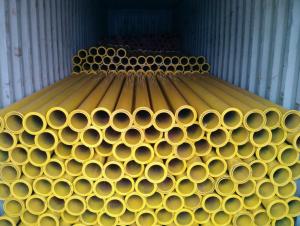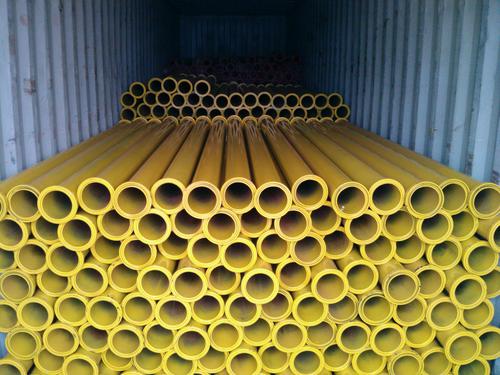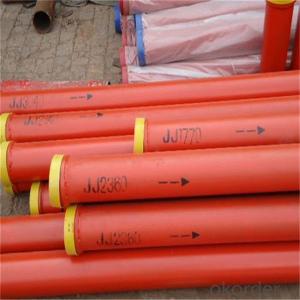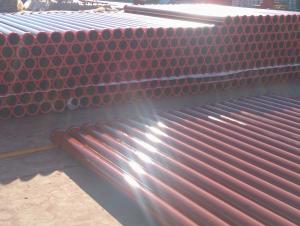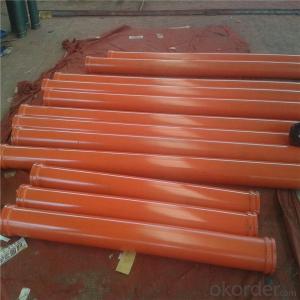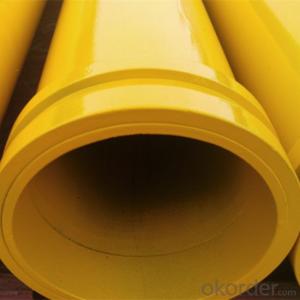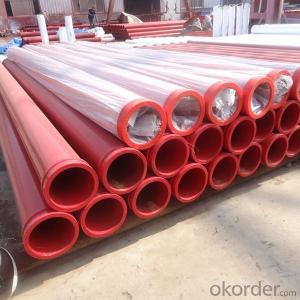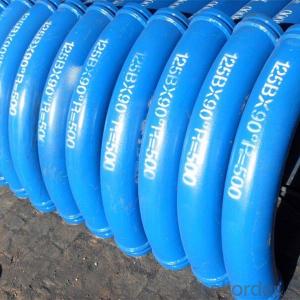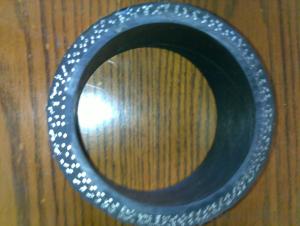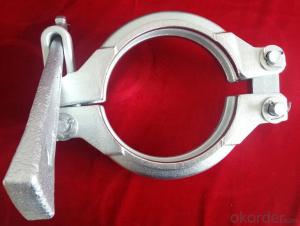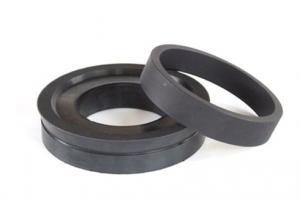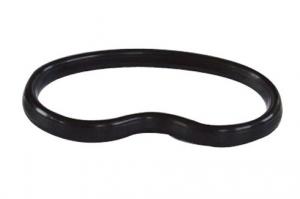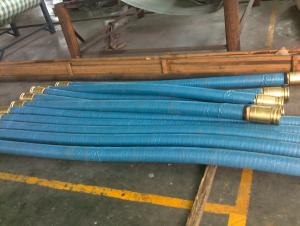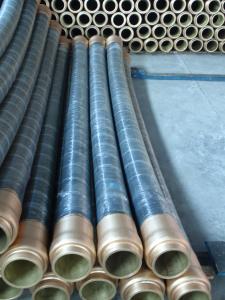Concrete Pump Delivery Pipe with SCHWING Flange
- Loading Port:
- Tianjin
- Payment Terms:
- TT or LC
- Min Order Qty:
- 5 pc
- Supply Capability:
- 10000 pc/month
OKorder Service Pledge
OKorder Financial Service
You Might Also Like
Product Description:
Production Name: Concrete Pump Delivery Pipe with SCHWING Flange
Materials: ST 52
Concrete Pumping Capacity: about20, 000M3
Inner Diameter: 125mm
Outer Diameter: 133mm
Thickness: 4.5mm
Length: 3000mm
Notes: total series of concrete delivery pipe for different brand concrete pump(PUTZMEISTER, SCHWING, CIFA, SANY, ZOOMLION, IHI, KYOKUTO Etc)available.
Scope of Application of the Equipment
Concrete Pump Delivery Pipe widely used on concrete pump truck, concrete placing boom, trailer concrete pump etc. Our concrete delivery pipes have been successfully exported to many countries from 1998, Our main markets as below: Middle East, Southeast Asia, America, Brazil, Italy, Russia, South Africa etc Aiming at the largest concrete pump parts manufacturer, and reliable, professional supplier in China, we can supply concrete pump elbows, delivery pipes, casting or forging couplings, end rubber hoses, rubber piston, tungsten wear plates, delivery cylinders, and other hydraulic parts, one stop service for your concrete pump parts and accessory business.
Product Advantages:
Concrete Pump Delivery Pipe are durable, strong, and resists corrosion.
Main Product Features:
· Premium quality
· Prompt delivery & seaworthy packing (10-20 days after receiving deposit)
Reliable performance
Easy and smooth operation
High safety.
· Professional Service
· Competitive pricing
Product Specifications:
Dimensions and masses of the complete pipe and its major components
FAQ:
Q1: Why buy Materials & Equipment from us?
A1: All products have their ISO certifications, and adheres to the highest standards and a commitment to supply chain safety and customer satisfaction.
Q2: How do we guarantee the quality of our products?
A2: We have established an advanced quality management system which conducts strict quality tests at every step, from raw materials to the final product. At the same time, we provide extensive follow-up service assurances as required.
Q3: How soon can we receive the product after purchase?
A3: Within three days of placing an order, we will begin production. The specific shipping date is dependent upon international and government factors, but is typically 10 to 30 workdays.
Q4: If we can produce some Concrete Pump Delivery Pipe according to customers request?
A4: Yes, we can produce Concrete Pump Delivery Pipe according to the difference country situations to make it suitable to the market and customers. We have very professional technical team to make the design.
Q5: How to make a quick resolution for after service?
A5:We have overseas branches all-around of world, IF needed, the seller shall dispatch 2 engineers to the buyer's site for supervision of training. The buyer shall make available of necessary facilities &skilled personnel at site for training.
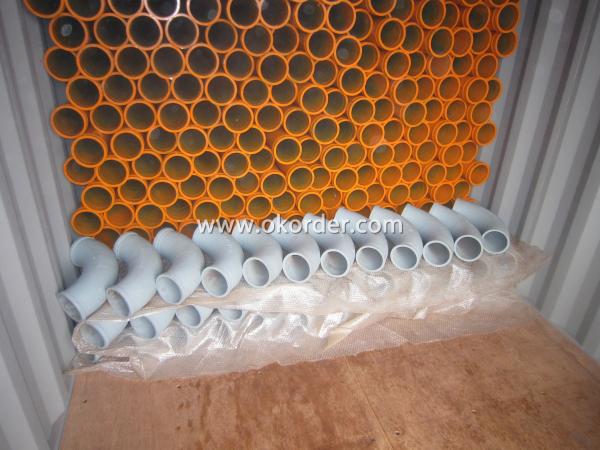
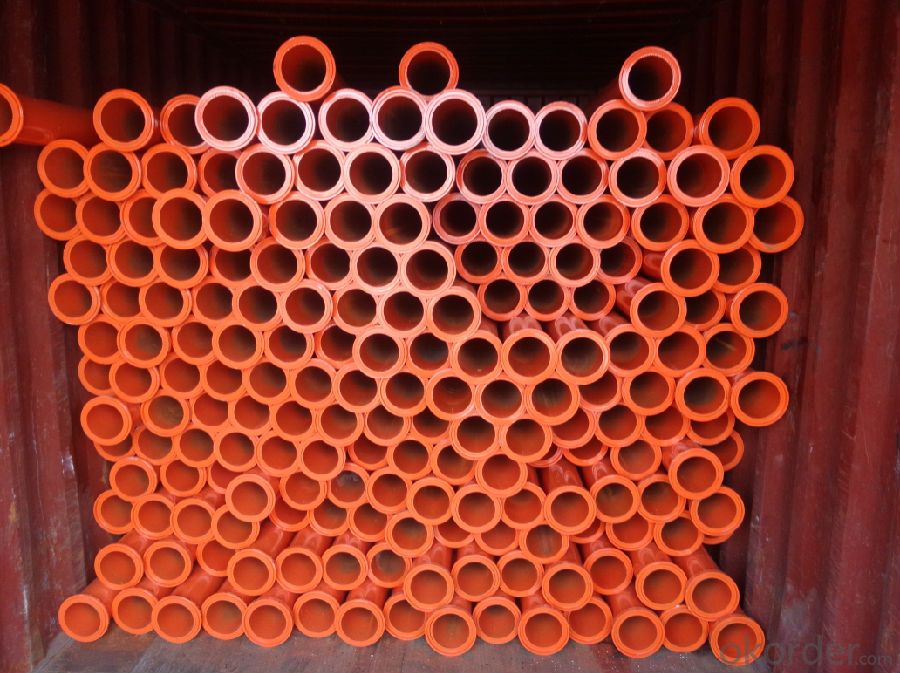
- Q: How can a faulty filter affect the pumping process?
- A faulty filter can significantly affect the pumping process in several ways. Firstly, a faulty filter may become clogged or blocked, hindering the flow of fluid through the pump. This can result in reduced efficiency and increased energy consumption as the pump has to work harder to overcome the resistance caused by the clogged filter. The decreased flow rate can also lead to longer pumping times, which can be problematic in time-sensitive applications. Secondly, a faulty filter may fail to effectively remove impurities or contaminants from the fluid being pumped. This can be particularly problematic in industries where maintaining the purity or cleanliness of the fluid is crucial, such as in pharmaceutical or food processing applications. The presence of contaminants can compromise the quality of the final product or damage equipment downstream from the pump. Furthermore, a faulty filter can lead to increased maintenance and repair costs. If the filter is not functioning properly, it may allow larger particles or debris to pass through, which can cause damage to the pump components. This can result in increased wear and tear, decreased lifespan of the pump, and the need for more frequent repairs or replacements. Lastly, a faulty filter can also pose a risk to the overall system and its components. If the filter fails completely, it may allow foreign objects or particles to enter the pump, leading to potential blockages, damage to internal components, or even complete failure of the pump. This can result in costly downtime, loss of production, and the need for emergency repairs or replacements. In summary, a faulty filter can have detrimental effects on the pumping process, including decreased efficiency, compromised fluid quality, increased maintenance costs, and potential damage to the pump and system components. Regular inspection, maintenance, and timely replacement of filters are essential to ensure smooth and reliable operation of pumps in various industries.
- Q: Can I get spare parts for concrete pump hydraulic cylinders and valves?
- Absolutely, spare parts for concrete pump hydraulic cylinders and valves are readily available. There is a wide range of companies and suppliers dedicated to supplying spare parts specifically for construction machinery, such as hydraulic cylinders and valves for concrete pumps. These spare parts can be conveniently obtained online or through nearby distributors. To ensure compatibility and proper operation of the spare parts, it is crucial to provide precise details about the make and model of your concrete pump. Furthermore, it is recommended to select reputable suppliers who offer authentic, top-notch spare parts for optimal performance and longevity.
- Q: What are the most commonly replaced spare parts for concrete pumps?
- Concrete pumps commonly require the replacement of certain spare parts. These parts, including wear plates, wear rings, and delivery cylinders, are prone to constant abrasion and wear. This is a result of the high pressures and velocities involved in the movement of concrete. Wear plates, usually made from hardened steel, are installed in high-wear areas such as the hopper to protect against the abrasive nature of concrete. On the other hand, wear rings, made from durable materials like polyurethane, are utilized to minimize friction between the piston and cylinder, thereby reducing wear and maintaining optimal performance. Additionally, delivery cylinders, also known as pumping cylinders, play a crucial role in transferring concrete from the hopper to the discharge outlet. Over time, the interior surface of the cylinder may experience wear or damage, necessitating replacement to ensure efficient concrete flow. Other commonly replaced spare parts include pistons, seals, hydraulic hoses, and couplings. These components, too, undergo wear and tear during the pumping process. It is essential to regularly inspect and maintain these parts to prevent unexpected equipment downtime and ensure the long-term reliability and performance of concrete pumps.
- Q: What are the signs of a clogged or damaged hydraulic filter?
- A clogged or damaged hydraulic filter may be indicated by several signs. One of the most common signs is a decrease in hydraulic system performance. If you observe a decrease in the speed or power of your hydraulic equipment, it may be due to a clogged filter that restricts the flow of hydraulic fluid. Another sign is an increase in heat within the hydraulic system. As the system struggles to maintain proper fluid flow and pressure, a clogged or damaged filter can cause it to overheat. Furthermore, unusual noises may be noticed coming from the hydraulic system. A clogged filter can result in air becoming trapped in the system, leading to strange noises like whining or grinding. Moreover, the presence of dirty or discolored hydraulic fluid could suggest a clogged or damaged filter. The filter's purpose is to remove dirt and contaminants from the fluid, so if it fails to do so effectively, the fluid will become dirty and discolored. Finally, frequent or recurring issues with the hydraulic system could be an indication of a clogged or damaged filter. The filter plays a critical role in maintaining the overall health of the hydraulic system, so if it is not functioning properly, it can lead to other problems such as pump failure or valve blockages. Regular inspection and replacement of hydraulic filters are crucial to ensure the proper functioning and longevity of your hydraulic system.
- Q: How often should the concrete pump wear plate be replaced?
- The frequency of replacing the concrete pump wear plate depends on several factors such as the type of concrete being pumped, the volume of concrete being pumped, and the operating conditions of the pump. Generally, wear plates are designed to withstand a certain amount of wear and tear before requiring replacement. In most cases, it is recommended to inspect the wear plate regularly to check for signs of excessive wear. This can include visible cracks, erosion, or a significant decrease in thickness. Regular visual inspections can help determine when it is time to replace the wear plate. Additionally, monitoring the pump's performance and efficiency can also provide insights into the wear and tear on the wear plate. If there is noticeable decrease in the pump's output or an increase in the required pumping pressure, it may indicate that the wear plate needs to be replaced. However, it is important to consult the manufacturer's guidelines and recommendations for your specific concrete pump model. They often provide recommendations on the expected lifespan of the wear plate and the intervals at which it should be replaced. Following these guidelines can help ensure optimal performance and longevity of your concrete pump.
- Q: What is the function of a concrete pump hopper grate handle?
- The main purpose of a handle on a concrete pump hopper grate is to manually control the opening and closing of the grate. The grate is an essential part of the pump as it allows concrete to enter the pumping system. By using the handle, the operator can adjust the position of the grate in order to control the flow of concrete and prevent any large debris or foreign objects from entering the system. This is crucial for ensuring the smooth operation of the pump and maintaining the quality of the pumped concrete. Additionally, the handle provides easy access to the grate for maintenance and cleaning purposes. Overall, the handle on the concrete pump hopper grate plays a crucial role in regulating the flow of concrete and ensuring the efficiency and reliability of the pumping process.
- Q: How often should hopper cylinder seals be replaced in a concrete pump?
- Hopper cylinder seals in a concrete pump should be replaced as soon as signs of wear or damage are observed. Regular inspection and maintenance can help identify the need for replacement, but the frequency ultimately depends on factors like usage, environmental conditions, and the quality of the seals. It is recommended to follow the manufacturer's guidelines and consult with professionals to determine the appropriate replacement schedule for hopper cylinder seals in a concrete pump.
- Q: Can I get spare parts for concrete pump wear plates and cutting rings?
- Yes, spare parts for concrete pump wear plates and cutting rings are typically available. They can be purchased from various suppliers and manufacturers specializing in construction equipment parts.
- Q: How often should agitator shaft seals be replaced in a concrete pump?
- The frequency at which agitator shaft seals should be replaced in a concrete pump depends on several factors such as the type and quality of the seal, the operational conditions of the pump, and the maintenance practices followed by the user. However, as a general guideline, it is recommended to inspect and replace agitator shaft seals in a concrete pump every 500 to 1,000 operating hours or annually, whichever comes first. Regular inspection of the seals is crucial to identify any signs of wear, leakage, or damage. If any of these issues are detected, immediate replacement is necessary to prevent further damage to the pump and ensure optimal performance. Additionally, it is essential to follow the manufacturer's recommendations and guidelines regarding seal replacements, as they may provide specific instructions based on the pump model and seal type. Proper maintenance practices, including regular cleaning and lubrication of the seals, can also extend their lifespan and reduce the need for frequent replacements. It is important to keep in mind that failure to replace worn or damaged agitator shaft seals in a timely manner can lead to increased downtime, decreased efficiency, and potential damage to other components of the concrete pump. Hence, it is crucial to prioritize regular inspection and replacement of agitator shaft seals to ensure the smooth operation and longevity of the concrete pump.
- Q: How do I ensure the reliability of concrete pump spare parts in critical applications?
- To ensure the reliability of concrete pump spare parts in critical applications, there are several steps you can take. 1. Choose reputable suppliers: Purchase spare parts from trusted and reliable suppliers who have a proven track record in the industry. Look for suppliers who specialize in concrete pump spare parts and have a good reputation for quality. 2. Conduct thorough research: Before making a purchase, research the specific spare parts you need and learn about their quality, durability, and performance. Read customer reviews and seek recommendations from industry professionals to ensure you are selecting the most reliable parts for your critical application. 3. Opt for genuine parts: Whenever possible, choose genuine spare parts provided by the original equipment manufacturer (OEM). These parts are specifically designed to fit and function with your concrete pump, ensuring optimal performance and reliability. 4. Regular maintenance and inspections: Implement a regular maintenance schedule and conduct thorough inspections of your concrete pump and its spare parts. This will help identify any potential issues or wear and tear before they become critical problems. 5. Quality control and testing: Before using new spare parts, conduct quality control checks and testing to ensure they meet the required standards. This can involve inspection of materials, dimensional checks, and performance testing to ensure reliability in critical applications. 6. Keep spare parts inventory: Maintain an adequate inventory of essential spare parts to minimize downtime in case of any failures. This will allow for timely replacement and reduce the chances of using substandard or counterfeit parts in critical applications. By following these steps, you can enhance the reliability of concrete pump spare parts in critical applications and minimize the risk of unexpected failures.
Send your message to us
Concrete Pump Delivery Pipe with SCHWING Flange
- Loading Port:
- Tianjin
- Payment Terms:
- TT or LC
- Min Order Qty:
- 5 pc
- Supply Capability:
- 10000 pc/month
OKorder Service Pledge
OKorder Financial Service
Similar products
Hot products
Hot Searches
Related keywords
